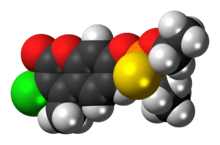Chemistry:Coumaphos

| |

| |
| Names | |
|---|---|
| Preferred IUPAC name
O-(3-Chloro-4-methyl-2-oxo-2H-1-benzopyran-7-yl) O,O-diethyl phosphorothioate | |
| Other names
3-Chloro-7-diethoxyphosphinothioyloxy-4-methyl-2-chromenone
Coumaphos, Meldane, Asuntol, Azunthol, Muscatox, Agridip, Asuntol, Meldone, Resitox, Baymix | |
| Identifiers | |
3D model (JSmol)
|
|
| ChEBI | |
| ChEMBL | |
| ChemSpider | |
| KEGG | |
PubChem CID
|
|
| UNII | |
| |
| |
| Properties | |
| C14H16ClO5PS | |
| Molar mass | 362.77 g/mol |
| Pharmacology | |
| 1=ATCvet code} | QP53AF08 (WHO) |
Except where otherwise noted, data are given for materials in their standard state (at 25 °C [77 °F], 100 kPa). | |
| Infobox references | |
Coumaphos is a nonvolatile, fat-soluble phosphorothioate with ectoparasiticide properties: it kills insects and mites. It is well known by a variety of brand names as a dip or wash, used on farm and domestic animals to control ticks, mites, flies and fleas.[1]
It is also used to control Varroa mites in honey bee colonies, though in many areas it is falling out of favor as the mites develop resistance and as the residual toxicity effects are becoming better understood.[2][3]
In Australia , its registration as suited to home veterinary use was cancelled by the Australian Pesticides and Veterinary Medicines Authority in June 2004 after the manufacturer failed to show it was safe for use on pets.[4]
The compound has been linked to neurological problems in bees, and may be a factor in colony collapse.[5]
It is classified as an extremely hazardous substance in the United States as defined in Section 302 of the U.S. Emergency Planning and Community Right-to-Know Act (42 U.S.C. § 11002), and is subject to strict reporting requirements by facilities which produce, store, or use it in significant quantities.[6]
References
- ↑ "Asuntol - Cattle, Goat, Sheep - anti lice, fleas, sucking flies and mite". vetcontact.com. http://www.vetcontact.com/en/art.php?a=52&t=.
- ↑ "A Review of Treatment Options for Control of Varroa Mite in New Zealand". biosecurity.govt.nz. http://www.biosecurity.govt.nz/pests-diseases/animals/varroa/paper/varroa-treatment-options.htm#8.
- ↑ Johnson, Reed M.; Ellis, Marion D.; Mullin, Christopher A.; Frazier, Maryann (2010). "Pesticides and honey bee toxicity – USA". Apidologie 41 (3): 312. doi:10.1051/apido/2010018. https://hal.archives-ouvertes.fr/hal-00892096/file/hal-00892096.pdf.
- ↑ "Coumaphos Review". http://www.apvma.gov.au/chemrev/coumaphos.shtml.
- ↑ "Neonicotinoid pesticides 'damage brains of bees'". BBC News. 27 March 2013. https://www.bbc.co.uk/news/science-environment-21958547.
- ↑ 40 C.F.R.: Appendix A to Part 355—The List of Extremely Hazardous Substances and Their Threshold Planning Quantities (July 1, 2008 ed.). Government Printing Office. http://edocket.access.gpo.gov/cfr_2008/julqtr/pdf/40cfr355AppA.pdf. Retrieved October 29, 2011.
External links
- Coumaphos, US Environmental Protection Agency
 |
